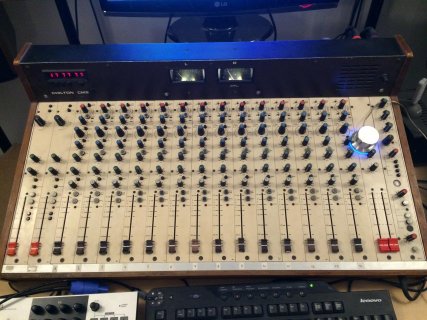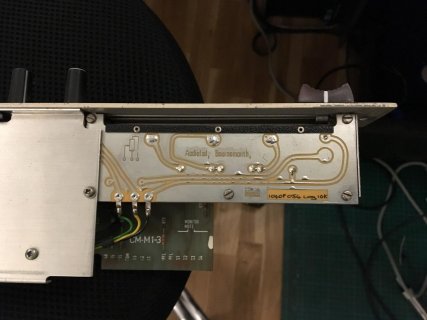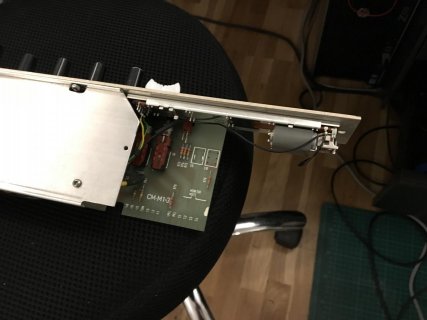Hi,
First of all: this is my first post!
I tried to accomplish my project just by reading through all the Teensy (& Arduino) Forums concerning Motor Fader DAW (Digital Audio Workstation - a PC running recording software, eg. Cubase) control, but after almost 8 month I finally decided to ask the community for help.
It all started with this project https://motorizedfader.wordpress.com/ - it made me think that I can easily extend the code/hardware to build my own multi channel DAW controller - and since I have a vintage, modular Chilton broadcast mixing desk at my studio, I though I might as well convert that into such a controller with the advantage that I can also use it for automation of analog mixes!
After a steep learning curve (this is my first hardware programming project...), I finally managed to to get the first 4 faders up and running with a Arduino MEGA, MIDI connection via rx/tx ports. However, the very unsmooth performance of the faders and bulkiness of the Arduino MEGA made me switch to Teensy.
So Instead of using the Arduino MEGA for all my 14 channels of faders, I now have two Teennsy 3.6. The idea is to have the first Teensy for Channels 1-8, connected to the DAW via USB and the second one for Channels 9-14, connected with MIDI via rx/tx ports.
As you can see in the video, the basic hardware control is working, but I am now facing problems with the MIDI connection.
Cody Hazelwood's code is using the Mackie HUI protocol for connection to the DAW. As I understand it, it receives "real" MIDI commands from the DAW (e.g. "pitchBend" for fader movement) but is sending back serial commands via the same ports for control of the DAW. This worked well with the rx/tx ports on the Arduino using the midi-library for receiving commands and sending back hex-codes, but I am now confused how this can be realised with Teensy's USB MIDI function.
e.g. receiving MIDI information:
e.g. sending back DAW control:
Does anybody have an idea if/how this can be realized with USB MIDI? Thx in advance!
Here are some pictures of the project, especially the necessary rework to fit in the new motorfaders with audio path (ALPS RSA0N12M9).
First of all: this is my first post!
I tried to accomplish my project just by reading through all the Teensy (& Arduino) Forums concerning Motor Fader DAW (Digital Audio Workstation - a PC running recording software, eg. Cubase) control, but after almost 8 month I finally decided to ask the community for help.
It all started with this project https://motorizedfader.wordpress.com/ - it made me think that I can easily extend the code/hardware to build my own multi channel DAW controller - and since I have a vintage, modular Chilton broadcast mixing desk at my studio, I though I might as well convert that into such a controller with the advantage that I can also use it for automation of analog mixes!
After a steep learning curve (this is my first hardware programming project...), I finally managed to to get the first 4 faders up and running with a Arduino MEGA, MIDI connection via rx/tx ports. However, the very unsmooth performance of the faders and bulkiness of the Arduino MEGA made me switch to Teensy.
So Instead of using the Arduino MEGA for all my 14 channels of faders, I now have two Teennsy 3.6. The idea is to have the first Teensy for Channels 1-8, connected to the DAW via USB and the second one for Channels 9-14, connected with MIDI via rx/tx ports.
As you can see in the video, the basic hardware control is working, but I am now facing problems with the MIDI connection.
e.g. receiving MIDI information:
Code:
if (MIDI.read() && MIDI.getChannel() == faderChannel && MIDI.getType() == PitchBend ) {
/* Bitwise math to take two 7 bit values for the PitchBend and convert to
a single 14 bit value. Then converts it to value between 0 and 1023
to control the fader. */
int value = (((MIDI.getData2() << 7) + MIDI.getData1()) / 16);
updateFader(value);
}e.g. sending back DAW control:
Code:
//Send MIDI Touch On Message
Serial.write(0x90);
Serial.write(0x67 + faderChannel);
Serial.write(0x7f);Does anybody have an idea if/how this can be realized with USB MIDI? Thx in advance!
Here are some pictures of the project, especially the necessary rework to fit in the new motorfaders with audio path (ALPS RSA0N12M9).





